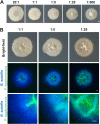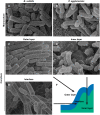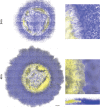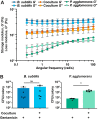A Dual-Species Biofilm with Emergent Mechanical and Protective Properties
- PMID: 30833350
- PMCID: PMC6707914
- DOI: 10.1128/JB.00670-18
A Dual-Species Biofilm with Emergent Mechanical and Protective Properties
Abstract
Many microbes coexist within biofilms, or multispecies communities of cells encased in an extracellular matrix. However, little is known about the microbe-microbe interactions relevant for creating these structures. In this study, we explored a striking dual-species biofilm between Bacillus subtilis and Pantoea agglomerans that exhibited characteristics that were not predictable from previous work examining monoculture biofilms. Coculture wrinkle formation required a P. agglomerans exopolysaccharide as well as the B. subtilis amyloid-like protein TasA. Unexpectedly, other B. subtilis matrix components essential for monoculture biofilm formation were not necessary for coculture wrinkling (e.g., the exopolysaccharide EPS, the hydrophobin BslA, and cell chaining). In addition, B. subtilis cell chaining prevented coculture wrinkling, even though chaining was previously associated with more robust monoculture biofilms. We also observed that increasing the relative proportion of P. agglomerans (which forms completely featureless monoculture colonies) increased coculture wrinkling. Using microscopy and rheology, we observed that these two bacteria assemble into an organized layered structure that reflects the physical properties of both monocultures. This partitioning into distinct regions negatively affected the survival of P. agglomerans while also serving as a protective mechanism in the presence of antibiotic stress. Taken together, these data indicate that studying cocultures is a productive avenue to identify novel mechanisms that drive the formation of structured microbial communities.IMPORTANCE In the environment, many microbes form biofilms. However, the interspecies interactions underlying bacterial coexistence within these biofilms remain understudied. Here, we mimic environmentally relevant biofilms by studying a dual-species biofilm formed between Bacillus subtilis and Pantoea agglomerans and subjecting the coculture to chemical and physical stressors that it may experience in the natural world. We determined that both bacteria contribute structural elements to the coculture, which is reflected in its overall viscoelastic behavior. Existence within the coculture can be either beneficial or detrimental depending on the context. Many of the features and determinants of the coculture biofilm appear distinct from those identified in monoculture biofilm studies, highlighting the importance of characterizing multispecies consortia to understand naturally occurring bacterial interactions.
Keywords: Bacillus subtilis; Pantoea agglomerans; antibiotic stress; biofilm; cell-cell interactions; coculture; dual-species; rheology; wrinkles.
Copyright © 2019 American Society for Microbiology.
Figures








Similar articles
-
The Exo-Polysaccharide Component of Extracellular Matrix is Essential for the Viscoelastic Properties of Bacillus subtilis Biofilms.Int J Mol Sci. 2020 Sep 15;21(18):6755. doi: 10.3390/ijms21186755. Int J Mol Sci. 2020. PMID: 32942569 Free PMC article.
-
Inhibition of Cell Differentiation in Bacillus subtilis by Pseudomonas protegens.J Bacteriol. 2015 Jul;197(13):2129-2138. doi: 10.1128/JB.02535-14. Epub 2015 Mar 30. J Bacteriol. 2015. PMID: 25825426 Free PMC article.
-
Lysinibacillus fusiformis M5 Induces Increased Complexity in Bacillus subtilis 168 Colony Biofilms via Hypoxanthine.J Bacteriol. 2017 Oct 17;199(22):e00204-17. doi: 10.1128/JB.00204-17. Print 2017 Nov 15. J Bacteriol. 2017. PMID: 28583948 Free PMC article.
-
Biofilm formation by Bacillus subtilis: new insights into regulatory strategies and assembly mechanisms.Mol Microbiol. 2014 Aug;93(4):587-98. doi: 10.1111/mmi.12697. Epub 2014 Jul 18. Mol Microbiol. 2014. PMID: 24988880 Free PMC article. Review.
-
Bacillus subtilis biofilm formation and social interactions.Nat Rev Microbiol. 2021 Sep;19(9):600-614. doi: 10.1038/s41579-021-00540-9. Epub 2021 Apr 6. Nat Rev Microbiol. 2021. PMID: 33824496 Review.
Cited by
-
The impact of primary colonizers on the community composition of river biofilm.PLoS One. 2023 Nov 13;18(11):e0288040. doi: 10.1371/journal.pone.0288040. eCollection 2023. PLoS One. 2023. PMID: 37956125 Free PMC article.
-
Systems view of Bacillus subtilis pellicle development.NPJ Biofilms Microbiomes. 2022 Apr 12;8(1):25. doi: 10.1038/s41522-022-00293-0. NPJ Biofilms Microbiomes. 2022. PMID: 35414070 Free PMC article.
-
Nitrate respiration occurs throughout the depth of mucoid and non-mucoid Pseudomonas aeruginosa submerged agar colony biofilms including the oxic zone.Sci Rep. 2022 May 20;12(1):8557. doi: 10.1038/s41598-022-11957-4. Sci Rep. 2022. PMID: 35595796 Free PMC article.
-
Bacillus velezensis stimulates resident rhizosphere Pseudomonas stutzeri for plant health through metabolic interactions.ISME J. 2022 Mar;16(3):774-787. doi: 10.1038/s41396-021-01125-3. Epub 2021 Sep 30. ISME J. 2022. PMID: 34593997 Free PMC article.
-
Decoding the impact of interspecies interactions on biofilm matrix components.Biofilm. 2025 Mar 14;9:100271. doi: 10.1016/j.bioflm.2025.100271. eCollection 2025 Jun. Biofilm. 2025. PMID: 40212915 Free PMC article.
References
Publication types
MeSH terms
Substances
Grants and funding
LinkOut - more resources
Full Text Sources
Other Literature Sources
Molecular Biology Databases

